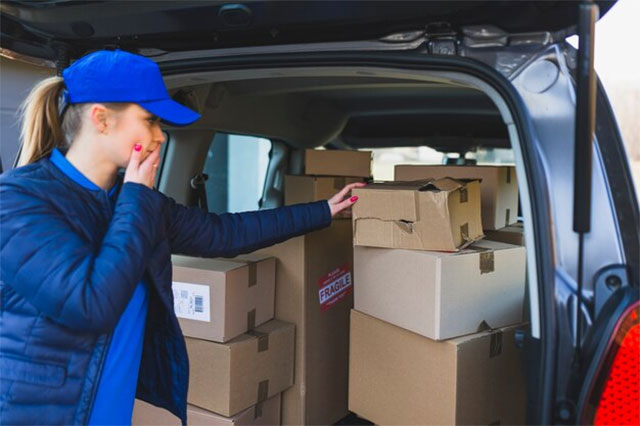A van’s primary purpose is to transport goods from A to B. But in order to transport these goods safely and efficiently, it is important to know your van’s maximum payload. Determining and complying with your payload capacity is crucial not only for the health of your vehicle – avoiding excess fuel consumption and unnecessary stress on the engine – but also to prevent potential legal repercussions.
The Driver and Vehicle Standards Agency (DVSA) is actively committed to road safety. With routine spot checks, they inspect more than 15,000 vans annually to ensure regulatory compliance. This highlights the need to adhere to payload guidelines, not only for safety and vehicle health but also to avoid significant financial penalties that can impact a business’s bottom line.

Table of Contents
What is payload capacity?
Payload capacity refers to the maximum amount of weight a van can safely carry, excluding the weight of the van itself. This includes the total weight of the cargo, passengers, and any additional equipment or modifications added to the van. It also includes operational fluids essential for the vehicle’s functioning, such as oil and fuel.
Why is it important?
- Safety: Overloading a van can significantly impact its handling and braking efficiency. A vehicle that’s too heavy may not brake effectively, increasing the risk of accidents. Also, the uneven distribution of weight can cause imbalance, making the vehicle harder to control.
- Vehicle health: Overloading your van consistently can lead to increased wear and tear on the vehicle’s suspension, brakes and transmission. Over time, this can shorten the lifespan and lead to frequent and expensive repairs.
- Legal implications: There are strict standards set by transportation authorities. Not sticking to these payload capacities isn’t just a minor oversight; it can have serious repercussions. The DVSA says getting stopped costs businesses anywhere up to £4,000 per day for each non-compliant vehicle. For businesses, especially small to medium-sized ones, such fines can be devastating.
- Invalidating insurance: If your van is found overloaded it can invalidate your van insurance and they can refuse to pay repair costs if it was overloaded at the time of an accident.
How to calculate payload capacity?
To determine a van’s payload capacity, you’ll need two key figures:
- Gross Vehicle Weight (GVW): This is the total weight a vehicle is allowed to handle when fully loaded. It includes the vehicle itself, operational fluids, cargo and passengers.
- Kerbweight: This is the weight of the van when it’s not carrying any cargo or passengers.
By subtracting the kerbweight from the GVW, you can determine the payload capacity. For example, if a van has a GVW of 3500kg and a kerbweight of 2500kg, its payload capacity stands at 1000kg.
Most vehicle manuals provide these figures. However, if you’ve made modifications to your van or have an older model, it might be beneficial to get the vehicle weighed at a certified weighbridge.
Penalties for exceeding a van’s gross vehicle weight
If your vehicle is found to be overweight, officers have the authority to halt your journey there and then. Overloading also carries heavy financial penalties. As of December 2021, the penalty structure is as follows:
- Exceeding by 5% to 10% results in a £100 penalty.
- Surpassing the limit by 10% to 15% incurs a £200 fine.
- Being over by 15% to 30% can set you back by £300.
- And if your vehicle is overloaded by 30% or more, be prepared for the possibility of facing legal action in court.
Staying informed about these regulations and routinely checking your vehicle’s weight is essential for both legal and safety reasons.
How to maximise your van’s payload
Driving an overloaded van doesn’t just put strain on the vehicle – it places you, as the driver or operator, under scrutiny too. Ensuring that your van doesn’t exceed its gross weight is solely on your shoulders. To get an accurate understanding of your van’s maximum allowable payload, refer to its VIN plate.
Now, if you’re scratching your head thinking about how to best use that space, here’s some advice to make sure you’re packing smart, driving safe, and staying on the right side of the law:
- Regular maintenance: Over time, accumulated debris, dirt or unnecessary items can add weight. It’s wise to regularly clean and declutter your van to keep it at its optimal weight.
- Pack smart: Ensure that the weight is distributed evenly across the van. This not only helps with maintaining the balance of the vehicle but also optimises space utilisation. Make use of racking systems or shelves that allow you to stack items without compromising safety.
- Upgrade if necessary: If you constantly struggle with managing the weight and space in your current van, it might be worth considering an upgrade to a larger model or even an additional van.
- Stay updated with regulations: Transportation regulations may change over time. It’s a good idea to keep an eye out for any updates in vehicle weight regulations to ensure you’re always in compliance.
- Educate your fleet: If you have a team, make sure everyone understands the importance of maximising payload without overloading. Regular training sessions can be beneficial.
- Safety first: While maximising payload is about efficient use of space and weight, never compromise on safety. Ensure all items are securely fastened and that the van’s weight limit is never exceeded.













